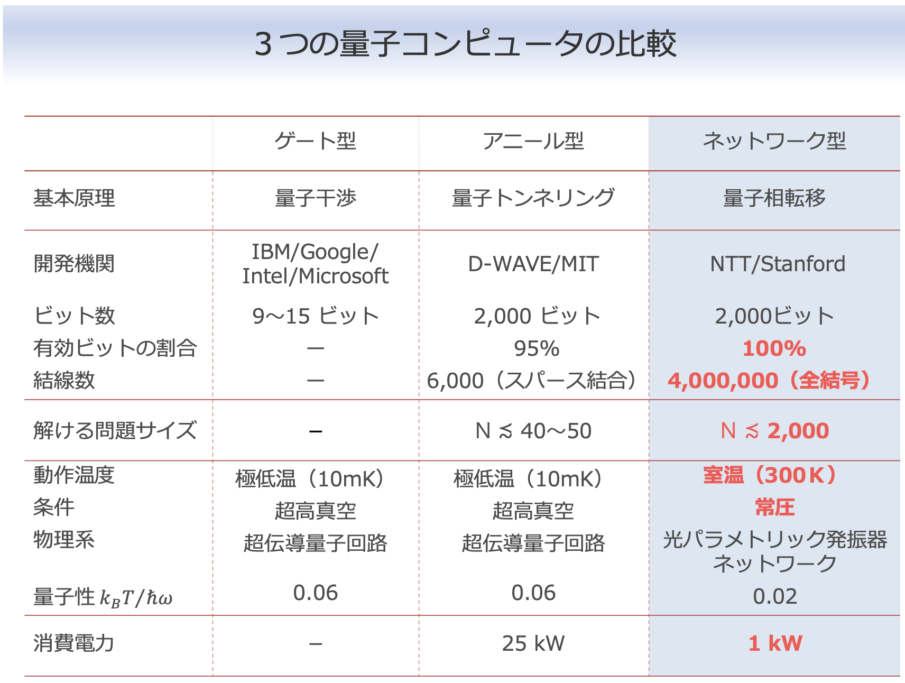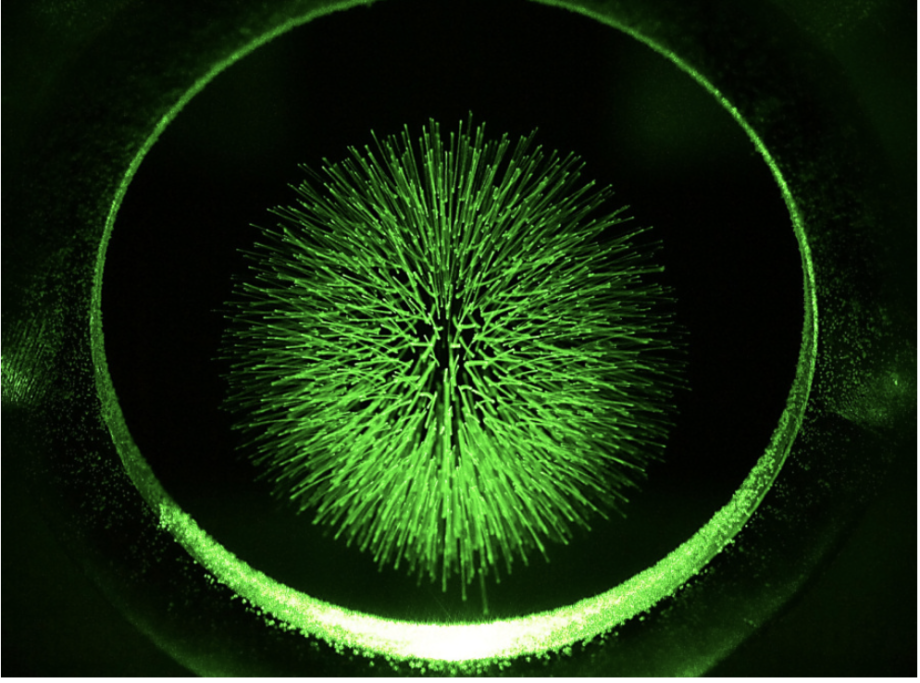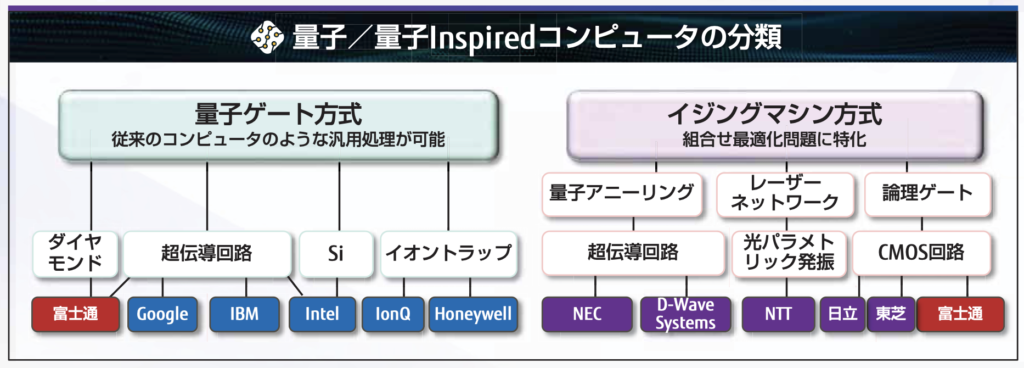はじめに
量子コンピュータは各社の開発競争が激化し、実用化も秒読みだ(参考)。また、クラウドベースでいえば、AmazonやGoogle、Microsoftがクラウド型の量子アプリケーションを提供している(参考)。今回は、そんな量子コンピュータの仕組みについて、特にトラップドイオン方式と超伝導方式に絞って解説している。興味のある人は是非トライしてほしい。
(出典:YouTube)
量子コンピュータ
革新的研究開発推進プログラム(ImPACT)の平成29年のレポートで示された3つの方式だ。当時はゲート型、アニール型、ネットワーク型といった分類が主流だった。
量子ビット
イオントラップ型(A trapped ion quantum computer)
大規模な量子コンピュータの実現方法として、トラップドイオン型量子コンピュータが提案されている。電磁場を用いてイオン(荷電原子粒子)を閉じ込め、各イオンの電子状態に量子ビット(Qubit)を格納する。イオントラップ型量子コンピュータは、スケーラブルで普遍的で有望な方式です。2018年4月現在で量子数20のイオントラップが実用化されている。イオントラップ法は、ドイツのボン大学の物理学者ウォルフガング・ポール(Wolfgang Paul, 1913年8月10日から1993年12月7日)が開発者の一人である。イオンなどの荷電粒子を、振動する高周波磁場と静電場の組み合わせにより、3次元四重極ポテンシャルを発生させて閉じ込めるものである。この研究により、ハンス・ゲオルク・デーメルト(Hans Georg Dehmelt, 1922年9月9日から2017年3月7日)とともに1989年のノーベル物理学賞を受賞している。

(出典:A QUADRUPAUL ION TRAP)
超伝導型
超伝導量子ビットを用いた量子コンピュータは、イオントラップの代わりに電気回路を搭載したチップを用いて、各電気回路の状態は量子ビットの状態に変換される。この量子ビットは、マイクロ波という電気的な入力によって操作する。超伝導量子ビットの基本原理は、超伝導キャパシタに帯電した電荷の振動であり、超伝導物質でできた電極同士をジョセフソン接合すると、通常の伝導による絶縁層通過は許されず、量子効果の一つであるトンネル効果による絶縁層通過のみが許された状況を作り出す。超伝導量子コンピュータの量子ゲート操作時間は1量子ビットゲートで数ナノ秒、2量子ビットゲートで数十~数百ナノ秒程度なので、原理的には数百個以上の量子ゲートを置くことが可能となる。超伝導方式の課題は、シリコンバルク誘電損失の問題と、準粒子発生の問題と、熱損失の問題の3つである。特に最後の熱損失問題に対応するには、極低温での制御信号の生成が必要となる。

(出典:日刊工業新聞)
8つの質問
Q1) What external factors can destroy the information in a quantum computer?
量子コンピュータの情報を破壊する外的要因には何があるかという設問だ。答えは、「不要な電場・磁場(unwanted electric and magnetic fields)」だろう。
Q2) What do quantum computers use to encode the information?
量子コンピュータは何を使って情報を暗号化するかという設問なので、解答は「量子ビット(Qubits:quantum bits)」だ。
Q3) How do quantum computers perform operations?
量子コンピュータはどのように演算を行うかという設問なので、「重ね合わせの利用(Using superposition)」だ。
Q4) What are some promising platforms to implement a quantum computer?
量子コンピュータを実現するための有望なプラットフォームは何かという設問だ。超伝導が選択肢にないので、「トラップイオン(Trapped ions)」だろう。
Q5) Why are quantum computers useful?
量子コンピュータはなぜ便利なのかという設問だ。「非常に複雑な計算を行うことができるから(They can carry out very very complex calculations)」かなあ。
Q6) Just like classical computers use bits to encode the information, quantum computers use qubits, or quantum bits. Why are quantum bits useful? What makes them special and more powerful compared to bits?
古典コンピュータがビットを用いて情報を符号化するように、量子コンピュータも量子ビットを用いる。量子ビットはなぜ便利か。通常のビットと比較して、何が特別で、何がより強力かという設問だ。量子コンピュータは、非常に複雑な問題を短時間で解決するのに有効であり、量子ビットは指数関数的に回転しているので、より多くの法則を超えられると期待されているので、英語なら次のような感じか。
Q7) Scientists around the world are developing many types of quantum computers. There are two particularly promising platforms right now. What are they? How do they differ? How are they similar?
世界中の科学者が様々なタイプの量子コンピュータを開発している。有望な2つのプラットフォームは何か。どこが違うのか、どこが似ているかという設問だ。量子コンピュータには、イオンを閉じ込めたものと、超伝導の量子ビットを使ったものがある。どちらも量子ビットを使うことで、従来のコンピュータよりも短時間で複雑な問題を解決できる。タップドイオン方式は非常に精密に操作することができ、寿命も長い。超伝導方式はトラップされたイオンよりはるかに高速に操作でき、回路数のスケールアップも容易なので、英語では次のような感じだろうか。
Q8) A lot of effort in building a quantum computer is dedicated to protecting and isolating the quantum states. What sort of external influences cause the quantum states to get destroyed?
量子コンピュータの構築では、量子状態の保護と分離に多くの労力が割かれている。どのような外部からの影響を受けると量子状態が破壊されるのかという設問だ。量子状態は非常に壊れやすく、温度や圧力の変動、迷走電磁場、近くの粒子との衝突などで簡単に破壊されるので、英語だと次のような感じか。
まとめ
これまでの分類では、量子ゲート方式、イジリングマシン方式、ネットワーク方式などと理解していた。今回の動画では紹介されたイオントラップも超伝導方式も、ともに量子ゲート方式の中の方式のようだ。これ以外に富士通が提唱するダイヤモンド方式やIntelが推奨するSi方式があるし、量子アニーリングを用いたイジリングマシン方式もある。これからの開発競争かは目を離せない。
(出典:富士通)
以上
最後まで読んだ頂きありがとうございます。
拝
参考:英文スクリプト
The contents of this metal cylinder could either revolutionize technology or be completely useless – it all depends on whether we can harness the strange physics of matter at very, very small scales.
To have even a chance of doing so, we have to control the environment precisely: the thick tabletop and legs guard against vibrations from footsteps, nearby elevators, and opening or closing doors. The cylinder is a vacuum chamber, devoid of all the gases in the air. Inside the vacuum chamber is a smaller, extremely cold compartment, reachable by tiny laser beams.
Inside are ultra-sensitive particles that make up a quantum computer. So what makes these particles worth the effort? In theory, quantum computers could outstrip the computational limits of classical computers. Classical computers process data in the form of bits. Each bit can switch between two states labeled zero and one.
A quantum computer uses something called a qubit, which can switch between zero, one, and what’s called a superposition. While the qubit is in its superposition, it has a lot more information than one or zero. you can think of these positions as points on a sphere: the north and south poles of the sphere represent one and zero. A bit can only switch between these two poles, but when a qubit is in its superposition, it can be at any point on the sphere.
We can’t locate it exactly – the moment we read it, the qubit resolves into a zero or a one. But even though we can’t observe the qubit in its superposition, we can manipulate it to perform particular operations while in this state.
So as a problem grows more complicated, a classical computer needs correspondingly more bits to solve it, while a quantum computer will theoretically be able to handle more and more complicated problems without requiring as many more qubits as a classical computer would need bits.
The unique properties of quantum computers result from the behavior of atomic and subatomic particles. These particles have quantum states, which correspond to the state of the qubit. Quantum states are incredibly fragile, easily destroyed by temperature and pressure fluctuations, stray electromagnetic fields, and collisions with nearby particles.
That’s why quantum computers need such n elaborate setup. It’s also why, for now, the power of quantum computers remains largely theoretical. So far, we can only control a few qubits in the same place at the same time.
There are two key components involved in managing these fickle quantum states effectively: the types of particles a quantum computer uses, and how it manipulates those particles.
For now, there are two leading approaches: trapped ions and superconducting qubits.
A trapped ion quantum computer uses ions as its particles and manipulates them with lasers. The ions are housed in a trap made of electrical fields. Inputs from the lasers tell the ions what operation to make by causing the qubit state to rotate on the sphere. To use a simplified example, the lasers could input the question: what are the prime factors of 15? In response, the ions may release photons – the state of the qubit determines whether the ion emits photons and how many photons it emits. An imaging system collects these photons and processes them to reveal the answer: 3 and 5.
Superconducting qubit quantum computers do the same thing in a different way: using a chip with electrical circuits instead of an ion trap. The states of each electrical circuit translate to the state of the qubit. They can be manipulated with electrical inputs in the form of microwaves. So: the qubits come from either ions or electrical circuits, acted on by either lasers or microwaves.
Each approach has advantages and disadvantages. Ions can be manipulated very precisely, and they last a long time, but as more ions are added to a trap, it becomes increasingly difficult to control each with precision. We can’t currently contain enough ions in a trap to make advanced computations, but one possible solution might be to connect many smaller traps that communicate with each other via photos rather than trying to create one big trap.
Superconducting circuits, meanwhile, make operations much faster than trapped ions, and it’s easier to scale up the number of circuits in a computer than the number of ions. But the circuits are also more fragile and gave a shorter overall lifespan. And as quantum computers advance, they will still be subject to the environmental constraints needed to preserve quantum states. But in spite of all these obstacles, we’ve already succeeded at making computations in a realm we can’t enter or even observe.
(discussion)
Scientists around the world, in universities and in large companies such as IBM, Google and Microsoft, are working hard to bring quantum computers to life. At the moment, they can control well only a few tens of qubits at a time, but we will need thousands of them to actually implement a useful computation. There are many areas which are thought to benefit a lot from quantum computers, such as security and encryption, modelling new materials and understanding matter, designing new drugs. On which aspect of your life do you think quantum computers will have the largest impact? How do you imagine life in the age of quantum computers?




